Minerals/Actinides
< MineralsActinide minerals, or actinides, are those with unusually high concentrations, atomic per cents, or weight per cents, of the actinide elements.
Autunites
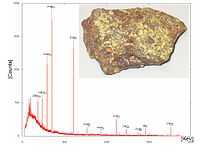
Elements usually emit a gamma-ray during nuclear decay or fission. The gamma-ray spectrum at right shows typical peaks for 226Ra, 214Pb, and 214Bi. These isotopes are part of the uranium-radium decay line. As 238U is an alpha-ray emitter, it is not shown. The peak at 40 keV is not from the mineral. From the color of the rock shown the yellowish mineral is likely to be autunite.
Autunite "occurs as [an] oxidizing product of uranium minerals in granite pegmatites and hydrothermal deposits."[1]
Carnotites
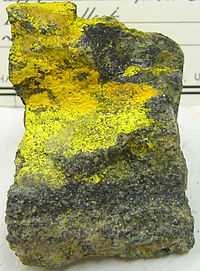
"Carnotite is a potassium uranium vanadate radioactive mineral with chemical formula: K2(UO2)2(VO4)2·3H2O. The water content can vary and small amounts of calcium, barium, magnesium, iron, and sodium are often present. ... Carnotite is a bright to greenish yellow mineral that occurs typically as crusts and flakes in sandstones. Amounts as low as one percent will color the sandstone a bright yellow. The high uranium content makes carnotite an important uranium ore and also radioactive. It is a secondary vanadium and uranium mineral usually found in sedimentary rocks in arid climates. It is an important ore of uranium in the Colorado Plateau region of the United States where it occurs as disseminations in sandstone and concentrations around petrified logs."[2]
Magnetites
"An excess of U234 is detected in some endogenic minerals."[3]
The presence of U234 suggests "an intensive uranium migration in the zone of epigenesis. A measurable U235 excess may accumulate as a result of the decay of some transuranium isotope, being present in the mineral. The surplus content of U235 in magnetites of a pegmatite vein by 45 plus or minus 5 and 23 plus or minus 6 percent is confirmed. The other minerals of this ore body have a normal isotopic composition which indicates the local presence of [a] transuranium emitter in the magnetite. An excess of actinium (and U234) is also found in this mineral."[3]
Monazites
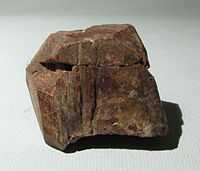
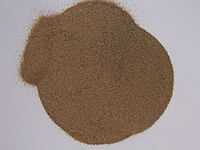
The primary source of the world's thorium is the rare-earth, and thorium, phosphate mineral monazite.
Pitchblendes
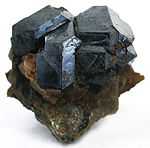
"Uraninite is a radioactive, uranium-rich mineral and ore with a chemical composition that is largely UO2, but also contains UO3 and oxides of lead, thorium, and rare earth elements. It is most commonly known as pitchblende (from pitch, because of its black color ... All uraninite minerals contain a small amount of radium as a radioactive decay product of uranium. Uraninite also always contains small amounts of the lead isotopes 206Pb and 207Pb, the end products of the decay series of the uranium isotopes 238U and 235U respectively. ... The extremely rare element technetium can be found in uraninite in very small quantities (about 0.2 ng/kg), produced by the spontaneous fission of uranium-238."[4]
The image at left shows well-formed crystals of uraninite. The image at right shows botryoidal unraninite. Because of the uranium decay products, both sources are gamma-ray emitters.
Thorianites
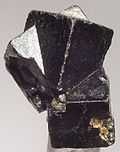
"Thorianite is a rare thorium oxide mineral, ThO2.[5] ... [It has a] high percentage of thorium; it also contains the oxides of uranium, lanthanum, cerium, praseodymium and neodymium. ... the mineral is slightly less radioactive than pitchblende, but is harder to shield due to its high energy gamma rays. It is common in the alluvial gem-gravels of Sri Lanka, where it occurs mostly as water worn, small, heavy, black, cubic crystals."[6]
Torbernites

"Torbernite ... is a radioactive, hydrated green copper uranyl phosphate mineral, found in granites and other uranium-bearing deposits as a secondary mineral. Torbernite is isostructural with the related uranium mineral, autunite. The chemical formula of torbenite is similar to that of autunite in which a Cu2+ cation replaces a Ca2+. The number of water hydration molecules can vary between 12 and 8, giving rise to the variety of metatorbernite when torbernite spontaneously dehydrates."[7]
Uraninites
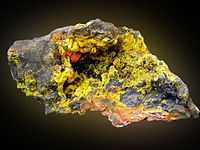
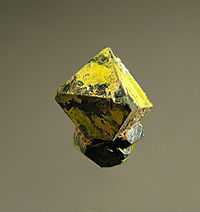
All of the known isotopes of astatine are very short-lived. Astatine occurs naturally in minerals such as uraninite as a decay product of uranium.
Uranophanes
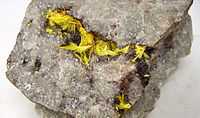
"Uranophane Ca(UO2)2(SiO3OH)2·5H2O is a rare calcium uranium [nesosilicate] hydrate mineral that forms from the oxidation of uranium bearing minerals. Uranophane is also known as uranotile. It has a yellow color and is radioactive."[8]
Research
Hypothesis:
- Minerals containing actinide elements should be closer to the center of the Earth than those high in the much lighter elements.
Control groups

The findings demonstrate a statistically systematic change from the status quo or the control group.
“In the design of experiments, treatments [or special properties or characteristics] are applied to [or observed in] experimental units in the treatment group(s).[9] In comparative experiments, members of the complementary group, the control group, receive either no treatment or a standard treatment.[10]"[11]
Proof of concept
Def. a “short and/or incomplete realization of a certain method or idea to demonstrate its feasibility"[12] is called a proof of concept.
Def. evidence that demonstrates that a concept is possible is called proof of concept.
The proof-of-concept structure consists of
- background,
- procedures,
- findings, and
- interpretation.[13]
See also
- Alkaline earth metal minerals
- Alkali metal minerals
- Alloy minerals
- Aluminum minerals
- Mineral astronomy
- Carbon minerals
- Chalcogen minerals
- Crystallography
- Gems
- Halogen minerals
- Heavy metal minerals
- Ices
- Metalloid minerals
- Metal minerals
- Metallurgy
- Mineralogy
- Noble gas minerals
- Optical mineralogy
- Pnictogen minerals
- Precious metal minerals
- Rare earth minerals
- Silicates
- Transition metal minerals
- Transuranic minerals
References
- ↑ "Autunite, In: Wikipedia". San Francisco, California: Wikimedia Foundation, Inc. February 21, 2013. Retrieved 2013-05-06.
- ↑ "Carnotite, In: Wikipedia". San Francisco, California: Wikimedia Foundation, Inc. March 20, 2013. Retrieved 2013-09-16.
- 1 2 Cherdyntsev, V.V.; Orlov, D.P.; Isabaev, E.A.; Ivanov, V.I. (01 January 1961). "Isotopes of Uranium in Natural Conditions. II. Isotopic Composition of Uranium of Minerals". Geokhimiya (U.S.S.R.) (in Russian). http://www.osti.gov/scitech/biblio/4818910. Retrieved 2015-04-04.
- ↑ "Uraninite, In: Wikipedia". San Francisco, California: Wikimedia Foundation, Inc. April 20, 2013. Retrieved 2013-05-08.
- ↑ C. Frondel (1958). Systematic Mineralogy of Uranium and Thorium. United States Government Printing Office.
- ↑ "Thorianite, In: Wikipedia". San Francisco, California: Wikimedia Foundation, Inc. February 27, 2013. Retrieved 2013-05-08.
- ↑ "Torbernite, In: Wikipedia". San Francisco, California: Wikimedia Foundation, Inc. February 27, 2013. Retrieved 2013-05-08.
- ↑ "Uranophane, In: Wikipedia". San Francisco, California: Wikimedia Foundation, Inc. February 28, 2013. Retrieved 2013-05-08.
- ↑ Klaus Hinkelmann, Oscar Kempthorne (2008). Design and Analysis of Experiments, Volume I: Introduction to Experimental Design (2nd ed.). Wiley. ISBN 978-0-471-72756-9. http://books.google.com/?id=T3wWj2kVYZgC&printsec=frontcover.
- ↑ R. A. Bailey (2008). Design of comparative experiments. Cambridge University Press. ISBN 978-0-521-68357-9. http://www.cambridge.org/uk/catalogue/catalogue.asp?isbn=9780521683579.
- ↑ "Treatment and control groups, In: Wikipedia". San Francisco, California: Wikimedia Foundation, Inc. May 18, 2012. Retrieved 2012-05-31.
- ↑ "proof of concept, In: Wiktionary". San Francisco, California: Wikimedia Foundation, Inc. November 10, 2012. Retrieved 2013-01-13.
- ↑ Ginger Lehrman and Ian B Hogue, Sarah Palmer, Cheryl Jennings, Celsa A Spina, Ann Wiegand, Alan L Landay, Robert W Coombs, Douglas D Richman, John W Mellors, John M Coffin, Ronald J Bosch, David M Margolis (August 13, 2005). "Depletion of latent HIV-1 infection in vivo: a proof-of-concept study". Lancet 366 (9485): 549-55. doi:10.1016/S0140-6736(05)67098-5. http://www.ncbi.nlm.nih.gov/pmc/articles/PMC1894952/. Retrieved 2012-05-09.
External links
![]() This is a research project at http://en.wikiversity.org
This is a research project at http://en.wikiversity.org
| |
Development status: this resource is experimental in nature. |
| |
Educational level: this is a research resource. |
| |
Resource type: this resource is an article. |
| |
Resource type: this resource contains a lecture or lecture notes. |
| |
Subject classification: this is a Geology resource. |